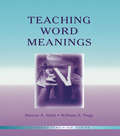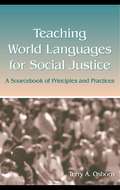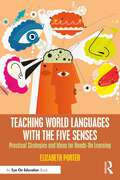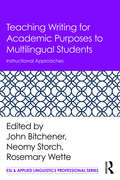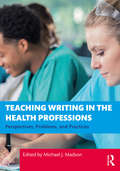- Table View
- List View
Teaching without Disruption in the Secondary School: A Practical Approach to Managing Pupil Behaviour
by Roland ChaplainBehaviour management training of trainee and qualified teachers has been a national priority for some time. This second edition addresses the point that this training and practice should be evidence-based. The importance of adopting a research-based approach is a specific requirement of the guidelines on teacher training and central to this book. The training materials in this book give examples of how to put the research into practice, which in turn makes the text more useful for self-development, trainers in schools and university education departments. Moreover, these materials are supported with case studies showing how they have been used successfully in schools throughout the UK.
Teaching without Tenure: Policies and Practices for a New Era
by Roger G. Baldwin Jay L. ChronisterThe growing use of full-time non-tenure-track faculty represents a controversial change in the pattern of staffing colleges and universities. Teaching without Tenure provides the first comprehensive examination of this important phenomenon. Examining the issue from the perspectives of both institutions and faculty members, Roger G. Baldwin and Jay L. Chronister offer a systematic look at who non-tenure-track faculty are, the roles they play in higher education, and the policies that control the terms and conditions of their employment. Teaching without Tenure utilizes findings from a national study of full-time non-tenure-track faculty, including survey data, policy analysis findings, and information gathered from site visits with faculty and administrators at a cross-section of four-year colleges and universities across the United States. This timely study emerges in an environment in which many constituents of higher education have begun to question the feasibility of retaining the academic tenure system in its present form. Baldwin and Chronister discuss the internal and external factors influencing an institution's decision to hire non-tenure-track faculty and make recommendations for policies and practices that can support the work and career development of faculty in these positions. Designed to assist faculty, academic leaders, and institutions, Teaching without Tenure examines developments challenging the status quo in the American academic profession and offers guidance as higher education moves into an uncertain future.
Teaching Women's and Gender Studies: Classroom Resources on Resistance, Representation, and Radical Hope (Grades 9-12)
by Kathryn Fishman-Weaver Jill ClinganIncorporate women’s and gender studies into your high school classroom using the powerful lesson plans in this book. The authors present seven units organized around four key concepts: Why WGST; Intersectionality; Motherland—History, Health, and Policy Change; and Artivism. With thought questions for activating prior knowledge, teaching notes, reflection questions, reproducibles, and strategies, these units are ready to integrate purposefully into your existing classroom practice. Across various subject areas and interdisciplinary courses, these lessons help to fill a critical gap in the curriculum. Through affirming, inclusive, and representative projects, this book offers actionable ways to encourage and support young people as they become changemakers for justice. This book is part of a series on teaching Women’s and Gender Studies in the K-12 classroom. We encourage readers to also check out the middle school edition.
Teaching Women’s and Gender Studies: Classroom Resources on Resistance, Representation, and Radical Hope (Grades 6-8)
by Kathryn Fishman-Weaver Jill ClinganIncorporate Women’s and Gender Studies into your middle school classroom using the powerful lesson plans in this book. The authors present seven units organized around four key concepts: Why WGST; Art, Emotion, and Resistance; Diversity, Inclusion, and Representation; and Intersectionality. With thought questions for activating prior knowledge, teaching notes, reflection questions, reproducibles, and strategies, these units are ready to integrate purposefully into your existing classroom practice. Across various subject areas and interdisciplinary courses, these lessons help to fill a critical gap in the curriculum. Through affirming, inclusive, and representative projects, this book offers actionable ways to encourage and support young people as they become changemakers for justice. This book is part of a series on teaching Women’s and Gender Studies in the K-12 classroom. We encourage readers to also check out the high school edition.
Teaching Women's and Gender Studies: Classroom Resources on Resistance, Representation, and Radical Hope (Grades 9-12)
by Kathryn Fishman-Weaver Jill ClinganIncorporate women’s and gender studies into your high school classroom using the powerful lesson plans in this book. The authors present seven units organized around four key concepts: Why WGST; Intersectionality; Motherland—History, Health, and Policy Change; and Artivism. With thought questions for activating prior knowledge, teaching notes, reflection questions, reproducibles, and strategies, these units are ready to integrate purposefully into your existing classroom practice. Across various subject areas and interdisciplinary courses, these lessons help to fill a critical gap in the curriculum. Through affirming, inclusive, and representative projects, this book offers actionable ways to encourage and support young people as they become changemakers for justice. This book is part of a series on teaching Women’s and Gender Studies in the K-12 classroom. We encourage readers to also check out the middle school edition.
Teaching Women’s and Gender Studies: Classroom Resources on Resistance, Representation, and Radical Hope (Grades 6-8)
by Kathryn Fishman-Weaver Jill ClinganIncorporate Women’s and Gender Studies into your middle school classroom using the powerful lesson plans in this book. The authors present seven units organized around four key concepts: Why WGST; Art, Emotion, and Resistance; Diversity, Inclusion, and Representation; and Intersectionality. With thought questions for activating prior knowledge, teaching notes, reflection questions, reproducibles, and strategies, these units are ready to integrate purposefully into your existing classroom practice. Across various subject areas and interdisciplinary courses, these lessons help to fill a critical gap in the curriculum. Through affirming, inclusive, and representative projects, this book offers actionable ways to encourage and support young people as they become changemakers for justice. This book is part of a series on teaching Women’s and Gender Studies in the K-12 classroom. We encourage readers to also check out the high school edition.
Teaching Women's History: Breaking Barriers and Undoing Male Centrism in K-12 Social Studies
by Kelsie Brook EckertTeaching Women’s History: Breaking Barriers and Undoing Male Centrism in K-12 Social Studies challenges and guides K-12 history teachers to incorporate comprehensive and diverse women’s history into every region and era of their history curriculum.Providing a wealth of practical examples, ideas, and lesson plans – all backed by scholarly research – for secondary and middle school classes, this book demonstrates how teachers can weave women’s history into their curriculum today. It breaks down how history is taught currently, how teachers are prepared, and what expectations are set in state standards and textbooks and then shows how teachers can use pedagogical approaches to better incorporate women’s voices into each of these realms. Each chapter explores a major barrier to teaching an inclusive history and how to overcome it, and every chapter ends with an inquiry-based lesson plan on women or using women's sources which stands counter to the way curriculum is traditionally taught, a case in point that tasks readers to realize how women have been integral to every period of history.With expert guidance from an award-winning social studies teacher, this guidebook will be important reading for middle and high school history educators. It will also be beneficial to preservice teachers, particularly within Social Studies Education and Gender Studies.Additional resources for educators are available to view at www.remedialherstory.com.
Teaching Women's History: Breaking Barriers and Undoing Male Centrism in K-12 Social Studies
by Kelsie Brook EckertTeaching Women’s History: Breaking Barriers and Undoing Male Centrism in K-12 Social Studies challenges and guides K-12 history teachers to incorporate comprehensive and diverse women’s history into every region and era of their history curriculum.Providing a wealth of practical examples, ideas, and lesson plans – all backed by scholarly research – for secondary and middle school classes, this book demonstrates how teachers can weave women’s history into their curriculum today. It breaks down how history is taught currently, how teachers are prepared, and what expectations are set in state standards and textbooks and then shows how teachers can use pedagogical approaches to better incorporate women’s voices into each of these realms. Each chapter explores a major barrier to teaching an inclusive history and how to overcome it, and every chapter ends with an inquiry-based lesson plan on women or using women's sources which stands counter to the way curriculum is traditionally taught, a case in point that tasks readers to realize how women have been integral to every period of history.With expert guidance from an award-winning social studies teacher, this guidebook will be important reading for middle and high school history educators. It will also be beneficial to preservice teachers, particularly within Social Studies Education and Gender Studies.Additional resources for educators are available to view at www.remedialherstory.com.
Teaching Word Meanings (Literacy Teaching Series)
by Steven A. Stahl William E. NagyLearning new words is foundational to success in school and life. Researchers have known for years that how many word meanings a student knows is one of the strongest predictors of how well that student will understand text and be able to communicate through writing. This book is about how children learn the meanings of new words (and the concepts they convey) and how teachers can be strategic in deciding which words to teach, how to teach them, and which words not to teach at all.This book offers a comprehensive approach to vocabulary instruction. It offers not just practical classroom activities for teaching words (though plenty of those are included), but ways that teachers can make the entire curriculum more effective at promoting students' vocabulary growth. It covers the 'why to' and 'when to' as well as the 'how to' of teaching word meanings.Key features of this exciting new book include:*A variety of vocabulary activities. Activities for teaching different kinds of words such as high frequency words, high utility words, and new concepts, are explained and illustrated.*Guidelines for choosing words. A chart provides a simple framework built around seven basic categories of words that helps teachers decide which words to teach and how to teach them.*Word learning strategies. Strategies are offered that will help students use context, word parts, and dictionaries more effectively.*Developing Word Consciousness. Although specific vocabulary instruction is fully covered, the primary goal of this book is to develop students' independent interest in words and their motivation to learn them.*Integrated Vocabulary Instruction. Teachers are encouraged to improve the reading vocabularies of their students by looking for opportunities to integrate vocabulary learning into activities that are undertaken for other purposes.
Teaching Word Meanings (Literacy Teaching Series)
by Steven A. Stahl William E. NagyLearning new words is foundational to success in school and life. Researchers have known for years that how many word meanings a student knows is one of the strongest predictors of how well that student will understand text and be able to communicate through writing. This book is about how children learn the meanings of new words (and the concepts they convey) and how teachers can be strategic in deciding which words to teach, how to teach them, and which words not to teach at all.This book offers a comprehensive approach to vocabulary instruction. It offers not just practical classroom activities for teaching words (though plenty of those are included), but ways that teachers can make the entire curriculum more effective at promoting students' vocabulary growth. It covers the 'why to' and 'when to' as well as the 'how to' of teaching word meanings.Key features of this exciting new book include:*A variety of vocabulary activities. Activities for teaching different kinds of words such as high frequency words, high utility words, and new concepts, are explained and illustrated.*Guidelines for choosing words. A chart provides a simple framework built around seven basic categories of words that helps teachers decide which words to teach and how to teach them.*Word learning strategies. Strategies are offered that will help students use context, word parts, and dictionaries more effectively.*Developing Word Consciousness. Although specific vocabulary instruction is fully covered, the primary goal of this book is to develop students' independent interest in words and their motivation to learn them.*Integrated Vocabulary Instruction. Teachers are encouraged to improve the reading vocabularies of their students by looking for opportunities to integrate vocabulary learning into activities that are undertaken for other purposes.
Teaching World History as Mystery
by Jack Zevin David GerwinOffering a philosophy, methodology, and examples for history instruction that are active, imaginative, and provocative, this text presents a fully developed pedagogy based on problem-solving methods that promote reasoning and judgment and restore a sense of imagination and participation to classroom learning. It is designed to draw readers into the detective process that characterizes the work of professional historians and social scientists ? sharing raw data, defining terms, building interpretations, and testing competing theories. An inquiry framework drives both the pedagogy and the choice of historical materials, with selections favoring the unsolved, controversial, and fragmented rather than the neatly wrapped up analysis of past events. Teaching World History as Mystery: Provides a balanced combination of interestingly arranged historical content, and clearly explained instructional strategies Features case studies of commonly and not so commonly taught topics within a typical world/global history curriculum using combinations of primary and secondary documents Discusses ways of dealing with ethical and moral issues in world history classrooms, drawing students into persisting questions of historical truth, bias, and judgment
Teaching World History as Mystery
by Jack Zevin David GerwinOffering a philosophy, methodology, and examples for history instruction that are active, imaginative, and provocative, this text presents a fully developed pedagogy based on problem-solving methods that promote reasoning and judgment and restore a sense of imagination and participation to classroom learning. It is designed to draw readers into the detective process that characterizes the work of professional historians and social scientists ? sharing raw data, defining terms, building interpretations, and testing competing theories. An inquiry framework drives both the pedagogy and the choice of historical materials, with selections favoring the unsolved, controversial, and fragmented rather than the neatly wrapped up analysis of past events. Teaching World History as Mystery: Provides a balanced combination of interestingly arranged historical content, and clearly explained instructional strategies Features case studies of commonly and not so commonly taught topics within a typical world/global history curriculum using combinations of primary and secondary documents Discusses ways of dealing with ethical and moral issues in world history classrooms, drawing students into persisting questions of historical truth, bias, and judgment
Teaching World Languages for Social Justice: A Sourcebook of Principles and Practices
by Terry A. OsbornTeaching World Languages for Social Justice: A Sourcebook of Principles and Practices offers principles based on theory, and innovative concepts, approaches, and practices illustrated through concrete examples, for promoting social justice and developing a critical praxis in foreign language classrooms in the U.S. and in wider world language communities. For educators seeking to translate these ideals into classroom practice in an environment dominated by the current standards movement and accountability measures, the critical insights on language education offered in this text will be widely welcomed.The text is designed as a sourcebook for translating theory into practice. Each chapter includes the theoretical base, guidelines for practice, discussion of the relationship to existing practices in the world language classroom, suggestions for activity development (which can be integrated into a professional portfolio), illustrative examples, questions for reflection, and additional suggested readings.Teaching World Languages for Social Justice is a primary or supplementary text for second and foreign language teaching methods courses and is equally appropriate for graduate courses in language education or educational studies.
Teaching World Languages for Social Justice: A Sourcebook of Principles and Practices
by Terry A. OsbornTeaching World Languages for Social Justice: A Sourcebook of Principles and Practices offers principles based on theory, and innovative concepts, approaches, and practices illustrated through concrete examples, for promoting social justice and developing a critical praxis in foreign language classrooms in the U.S. and in wider world language communities. For educators seeking to translate these ideals into classroom practice in an environment dominated by the current standards movement and accountability measures, the critical insights on language education offered in this text will be widely welcomed.The text is designed as a sourcebook for translating theory into practice. Each chapter includes the theoretical base, guidelines for practice, discussion of the relationship to existing practices in the world language classroom, suggestions for activity development (which can be integrated into a professional portfolio), illustrative examples, questions for reflection, and additional suggested readings.Teaching World Languages for Social Justice is a primary or supplementary text for second and foreign language teaching methods courses and is equally appropriate for graduate courses in language education or educational studies.
Teaching World Languages with the Five Senses: Practical Strategies and Ideas for Hands-On Learning
by Elizabeth PorterWith this fun, practical guide, you will have everything you need to re-envision and reinvigorate your world language classroom. Author Elizabeth Porter draws on a brain-based approach to show how language learning is a sensory experience. Students can effectively learn languages and improve retention through activities and lessons that incorporate the five senses – sight, hearing, taste, touch, and smell. Chapters include real-world, research-backed examples and classroom strategies and activities ready for use. An essential resource for world language teachers, this book introduces language learning philosophy and an out-of-the-box, effective approach that uses neuroscience combined with best practices to promote a highly engaging language learning environment.
Teaching World Languages with the Five Senses: Practical Strategies and Ideas for Hands-On Learning
by Elizabeth PorterWith this fun, practical guide, you will have everything you need to re-envision and reinvigorate your world language classroom. Author Elizabeth Porter draws on a brain-based approach to show how language learning is a sensory experience. Students can effectively learn languages and improve retention through activities and lessons that incorporate the five senses – sight, hearing, taste, touch, and smell. Chapters include real-world, research-backed examples and classroom strategies and activities ready for use. An essential resource for world language teachers, this book introduces language learning philosophy and an out-of-the-box, effective approach that uses neuroscience combined with best practices to promote a highly engaging language learning environment.
Teaching Writing: Effective approaches for the middle years
by Tessa DaffernIn the 21st century, writing is more important than at any other time in human history. Yet much of the emphasis in schooling has been on reading, and after the early years, writing skills have been given less attention. Internationally, too many children are leaving school without the writing skills they need to succeed in life. The evidence indicates that students rarely develop proficiency as writers without effective teacher instruction. Teaching Writing offers a comprehensive approach for the middle years of schooling, when the groundwork should be laid for the demanding writing tasks of senior school and the workplace. Teaching Writing outlines evidence-based principles of writing instruction for upper primary students and young adolescents. It presents strategies that are ready for adoption or adaptation, and exemplars to assist with designing and implementing writing lessons across the middle years of school. It addresses writing from a multimodal perspective while also highlighting the importance of teaching linguistic aspects of text design such as sentence structure, vocabulary and spelling as foundations for meaning-making. Contributors argue that students need to continue to develop their skills in both handwriting and keyboarding. Examples of the teaching of writing across disciplines are presented through a range of vignettes. Strategies for assessing student writing and for supporting students with diverse needs are also explored. With contributions from leading literacy educators, Teaching Writing is an invaluable resource for primary, secondary and pre-service teachers.
Teaching Writing: Effective approaches for the middle years
by Tessa Daffern Noella M. MackenzieIn the 21st century, writing is more important than at any other time in human history. Yet much of the emphasis in schooling has been on reading, and after the early years, writing skills have been given less attention. Internationally, too many children are leaving school without the writing skills they need to succeed in life. The evidence indicates that students rarely develop proficiency as writers without effective teacher instruction. Teaching Writing offers a comprehensive approach for the middle years of schooling, when the groundwork should be laid for the demanding writing tasks of senior school and the workplace. Teaching Writing outlines evidence-based principles of writing instruction for upper primary students and young adolescents. It presents strategies that are ready for adoption or adaptation, and exemplars to assist with designing and implementing writing lessons across the middle years of school. It addresses writing from a multimodal perspective while also highlighting the importance of teaching linguistic aspects of text design such as sentence structure, vocabulary and spelling as foundations for meaning-making. Contributors argue that students need to continue to develop their skills in both handwriting and keyboarding. Examples of the teaching of writing across disciplines are presented through a range of vignettes. Strategies for assessing student writing and for supporting students with diverse needs are also explored. With contributions from leading literacy educators, Teaching Writing is an invaluable resource for primary, secondary and pre-service teachers.
Teaching Writing for Academic Purposes to Multilingual Students: Instructional Approaches (ESL & Applied Linguistics Professional Series)
by John Bitchener Neomy Storch Rosemary WetteExamining what is involved in learning to write for academic purposes from a variety of perspectives, this book focuses in particular on issues related to academic writing instruction in diverse contexts, both geographical and disciplinary. Informed by current theory and research, leading experts in the field explain and illustrate instructional programs, tasks, and activities that help L2/multilingual writers develop knowledge of different genres, disciplinary expectations, and expertise in applying what they have learned in both educational and professional contexts.
Teaching Writing for Academic Purposes to Multilingual Students: Instructional Approaches (ESL & Applied Linguistics Professional Series)
by John Bitchener Neomy Storch Rosemary WetteExamining what is involved in learning to write for academic purposes from a variety of perspectives, this book focuses in particular on issues related to academic writing instruction in diverse contexts, both geographical and disciplinary. Informed by current theory and research, leading experts in the field explain and illustrate instructional programs, tasks, and activities that help L2/multilingual writers develop knowledge of different genres, disciplinary expectations, and expertise in applying what they have learned in both educational and professional contexts.
Teaching Writing in Chinese Speaking Areas (Studies in Writing #16)
by Mark Shiu-Kee Shum De-Lu ZhangOne of the most civilized nations in history, China has a long-standing writing tradition and many Chinese texts have become world treasures. However, the way the Chinese teach writing in various countries in contemporary times is little known to the outside world, especially in Western countries. Undoubtedly, the Chinese have had an established traditional method of writing instruction. However, recent social and political developments have created the perception amongst both practitioners and researchers of a need for change. Whilst certain socio-political changes, both in Mainland China and in the territories, acted as agents for reform of the teaching of composition, the shape these reforms are taking has been due to many different influences, coming both from inside the countries themselves and from foreign sources. Mainland China, Hong Kong, Taiwan and Singapore have each developed their own approach to the teaching of composition.
Teaching Writing in English as a Foreign Language: Teachers’ Cognition Formation and Reformation (English Language Education #28)
by Huan Zhao Lawrence Jun ZhangThis book explores teachers’ cognitions about the teaching of writing in English as a foreign language (EFL) and their teaching practice, as well as factors influencing the formation and reformation process of their cognition. Taking stock of Bakhtin’s dialogism as the theoretical framework, the authors argue that the formation and reformation of teacher cognition is a dialogic process. A systematic analysis of participating teachers’ cognition formation and re-formation process suggests the highly individual nature of teachers’ cognitions. EFL researchers and teachers, teacher educators, teacher education policymakers, university administrators and EFL textbook writers could draw on the findings of the study to provide better resources to implement the teaching of EFL writing more effectively. The study has adopted a mixed-methods approach, whose quantitative results show the patterns and differences of teacher cognition among teachers of different backgrounds and with different schooling, education and working experiences. The qualitative findings show in detail teachers' cognition formation and reformation processes and the factors contributing to such processes, revealing convergence and divergence of teachers’ stated cognitions, with a focus on the discrepancy between teacher cognition and teaching practice. These are useful lenses through which researchers and teachers will find significant implications for offering EFL writing instruction more effectively.
Teaching Writing in the Health Professions: Perspectives, Problems, and Practices
by Michael J. MadsonThis collection provides a research-based guide to instructional practices for writing in the health professions, promoting faculty development and bringing together perspectives from writing studies, technical communication, and health humanities. With employment in health-care sectors booming, writing instruction tailored for the health professions is in high demand. Writing instruction is critical in the health professions because health professionals, current and aspiring, need to communicate persuasively with patients, peers, mentors, and others. Writing instruction can also help cultivate professional identity, reflective practice, empathy, critical thinking, confidence, and organization, as well as research skills. This collection prepares faculty and administrators to meet this demand. It combines conceptual development of writing for the health professions as an emergent interdiscipline with evidence-based practices for instructors in academic, clinical, and community settings. Teaching Writing in the Health Professions is an essential resource for instructors, scholars, and program administrators in health disciplines, professional and technical communication, health humanities, and interdisciplinary writing studies. It informs the teaching of writing in programs in medicine, nursing, pharmacy and allied health, public health, and other related professions.
Teaching Writing in the Health Professions: Perspectives, Problems, and Practices
by Michael J. MadsonThis collection provides a research-based guide to instructional practices for writing in the health professions, promoting faculty development and bringing together perspectives from writing studies, technical communication, and health humanities. With employment in health-care sectors booming, writing instruction tailored for the health professions is in high demand. Writing instruction is critical in the health professions because health professionals, current and aspiring, need to communicate persuasively with patients, peers, mentors, and others. Writing instruction can also help cultivate professional identity, reflective practice, empathy, critical thinking, confidence, and organization, as well as research skills. This collection prepares faculty and administrators to meet this demand. It combines conceptual development of writing for the health professions as an emergent interdiscipline with evidence-based practices for instructors in academic, clinical, and community settings. Teaching Writing in the Health Professions is an essential resource for instructors, scholars, and program administrators in health disciplines, professional and technical communication, health humanities, and interdisciplinary writing studies. It informs the teaching of writing in programs in medicine, nursing, pharmacy and allied health, public health, and other related professions.
Teaching Writing to Children in Indigenous Languages: Instructional Practices from Global Contexts (Routledge Research in Education #37)
by Ari Sherris Joy Kreeft PeytonThis volume brings together studies of instructional writing practices and the products of those practices from diverse Indigenous languages and cultures. By analyzing a rich diversity of contexts—Finland, Ghana, Hawaii, Mexico, Papua New Guinea, and more—through biliteracy, complexity, and genre theories, this book explores and demonstrates critical components of writing pedagogy and development. Because the volume focuses on Indigenous languages, it questions center-margin perspectives on schooling and national language ideologies, which often limit the number of Indigenous languages taught, the domains of study, and the age groups included.





